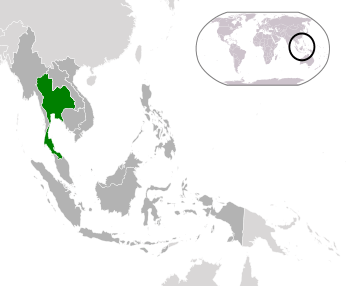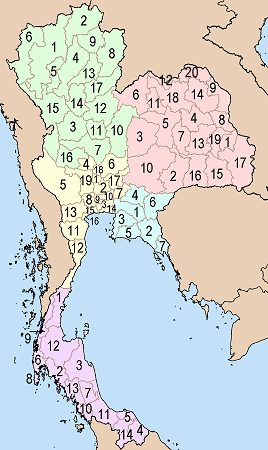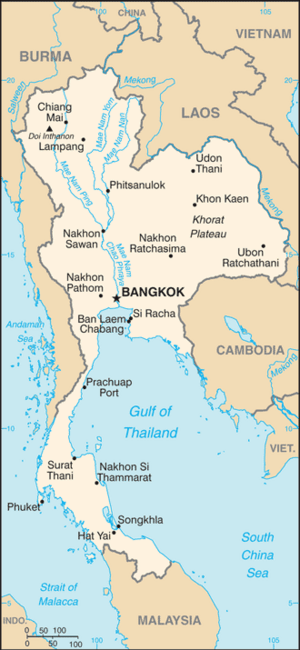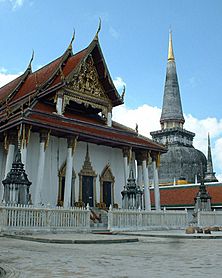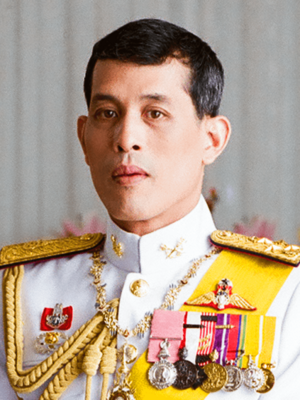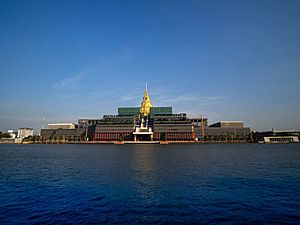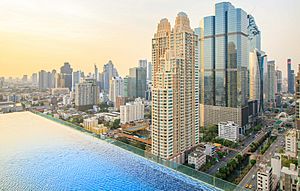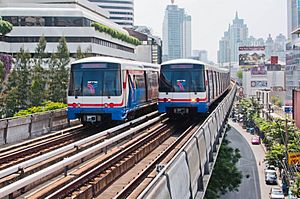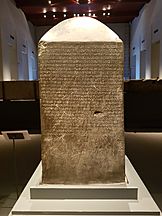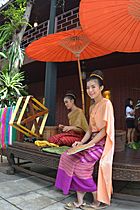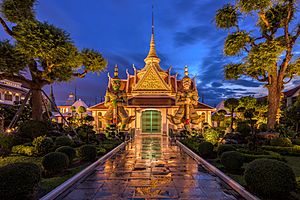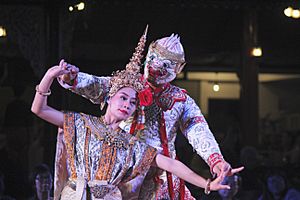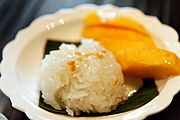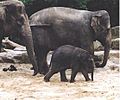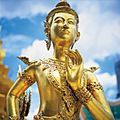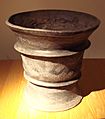Thailand facts for kids
Quick facts for kids
Kingdom of Thailand
|
|
|---|---|
|
|
|
|
Anthem: เพลงชาติไทย
Phleng Chat Thai "Thai National Anthem" |
|
|
Location of Thailand (green)
|
|
| Capital and largest city
|
Bangkok 13°48′N 100°33′E / 13.800°N 100.550°E |
| Official languages | Thai |
|
Spoken languages
|
See for full list |
| Ethnic groups |
|
| Religion
(2018 census)
|
|
| Demonym(s) | Thai |
| Government | Unitary parliamentary constitutional monarchy |
|
• Monarch
|
Vajiralongkorn (Rama X) |
| Anutin Charnvirakul | |
| Legislature | National Assembly |
| Senate | |
| House of Representatives | |
| Formation | |
| 1238–1438 | |
| 1351–1767 | |
| 1767–1782 | |
|
• Rattanakosin Kingdom
|
6 April 1782 |
|
• Constitutional monarchy
|
24 June 1932 |
|
• Current constitution
|
6 April 2017 |
| Area | |
|
• Total
|
513,120 km2 (198,120 sq mi) (50th) |
|
• Water (%)
|
0.4 (2,230 km2) |
| Population | |
|
• 2024 estimate
|
|
|
• 2010 census
|
64,785,909 (21st) |
|
• Density
|
132.1/km2 (342.1/sq mi) (88th) |
| GDP (PPP) | 2025 estimate |
|
• Total
|
|
|
• Per capita
|
|
| GDP (nominal) | 2025 estimate |
|
• Total
|
|
|
• Per capita
|
|
| Gini (2021) | ▲ 35.1 medium |
| HDI (2023) | high · 76th |
| Currency | Thai baht (฿) (THB) |
| Time zone | UTC+7 (ICT) |
| Date format | dd/mm/yyyy (BE) |
| Driving side | left |
| Calling code | +66 |
| ISO 3166 code | TH |
| Internet TLD |
|
Thailand, officially the Kingdom of Thailand, is a country in Southeast Asia. Its neighbors are Laos, Cambodia, Malaysia, and Myanmar. The country's name was Siam until June 24 1939. It was called Siam again from 1945 to May 11 1949. The word Thai (ไทย) comes from the main ethnic group in central Thailand. The capital city is Bangkok. Thailand is special because it was the only country in Southeast Asia not ruled by Western powers. It acted as a buffer zone between English and French colonies.
Thailand is a constitutional monarchy. This means it has a King as the head of state. The King's power is limited by a constitution.
Most people in Thailand (95%) follow Buddhism. However, a small group, mainly in the south, follow Islam. Other religions in Thailand include Christianity, Hinduism, and Sikhism.
Contents
- Thailand's Past: A Journey Through History
- Exploring Thailand's Diverse Geography
- Thailand's Climate and Seasons
- Thailand's Provinces: Exploring the Regions
- How Thailand is Governed
- Thailand's Economy: How the Country Makes Money
- Getting Around: Transportation in Thailand
- Thai Culture: Traditions and Arts
- Images for kids
- See also
Thailand's Past: A Journey Through History
Many people believe the first Thai state was the Buddhist kingdom of Sukhothai. It was founded in 1238. Sukhothai gained its freedom from the kingdom of Cambodia.
About a hundred years later, a larger Thai kingdom called Ayutthaya grew in the south. Sukhothai later became part of Ayutthaya. Ayutthaya lasted over 400 years. It fell after an attack by a kingdom from Myanmar.
A Thai soldier of Chinese background then started a new capital city at Thonburi. He became King Tāksin. Thonburi was the capital for only a short time.
The current era, called Rattanakosin, began when Bangkok became the capital. This happened under King Rama I of the Chakri Dynasty.
Before 1932, Thailand was an absolute monarchy. This meant the King had complete power. On June 24, 1932, a group of people changed Thailand to a constitutional monarchy. This limited the King's power. Thai people first voted for a Prime Minister in an election in 1973. There have been several changes in government by the military both before and after this year.
On September 19, 2006, the army took control from the government. In May 2014, another military change in government happened. Between 1932 and 2014, Thailand had 12 such changes.
Exploring Thailand's Diverse Geography
Thailand covers 513,120 square kilometres (198,120 sq mi). It is the 50th-largest country in the world. It is a bit smaller than Yemen and a bit larger than Spain.
Thailand has several different natural areas. The north is mountainous, with Doi Inthanon being the highest point at 2,565 metres (8,415 ft). The northeast, called Isan, has the Khorat Plateau. The Mekong River borders it to the east. Central Thailand has the flat Chao Phraya river valley. This river flows into the Gulf of Thailand.
Southern Thailand has a narrow strip of land called the Kra Isthmus. This widens into the Malay Peninsula. Thailand's regions differ in people, resources, and development. This variety is a key feature of Thailand's landscape.
The Chao Phraya and Mekong Rivers are very important for rural Thailand. Farmers use these rivers and their smaller streams for growing crops. The Gulf of Thailand covers 320,000 square kilometres (124,000 sq mi). It gets water from the Chao Phraya and other rivers. Its clear, shallow waters help the tourism industry. The eastern side of the Gulf is an industrial area. It has major ports like Sattahip and Laem Chabang.
The Andaman Sea is also a valuable natural resource. It has popular resorts like Phuket and Krabi. Even after the 2004 tsunami, these areas remain popular with tourists.
Thailand's Climate and Seasons
Thailand's weather is shaped by monsoon winds. These winds bring different seasons. Most of the country has a tropical savanna climate. This means it's hot with wet and dry seasons. Parts of the south have a tropical monsoon climate or a tropical rainforest climate. These areas get more rain.
A year in Thailand has three main seasons:
- Rainy Season: From mid-May to mid-October. Southwestern winds from the Indian Ocean bring rain. August and September are the wettest months. The country gets about 1,200 to 1,600 mm (47 to 63 in) of rain each year.
- Winter Season: From mid-October to mid-February. Most of Thailand has dry weather and mild temperatures.
- Summer Season: From mid-February to mid-May. Inland areas like the north and northeast get very hot. Temperatures can reach 40 °C (104 °F) from March to May. In winter, some areas can get close to or below 0 °C (32 °F). Southern Thailand has mild weather all year. It gets a lot of rain, especially in October and November.
Thailand is one of the top ten countries most affected by climate change. It is very sensitive to rising sea levels and extreme weather.
Nature and Wildlife Conservation

Thailand has many national parks. These are areas with important natural resources or unique beauty. They also protect special plants and animals. Thailand has 156 national parks, 58 wildlife sanctuaries, and many other protected areas. These cover almost 31% of the country.
The Department of National Parks, Wildlife and Plant Conservation manages these areas. Thailand is working to improve its environmental performance. It ranks 91st out of 180 countries in the 2016 Environmental Performance Index.
The number of elephants, Thailand's national symbol, has dropped a lot. From 100,000 in 1850, it's now around 2,000. Poachers hunt elephants for their ivory and hides. Young elephants are sometimes caught for tourist attractions. Their use has decreased since logging was banned in 1989.
Hunting protected animals is still a big problem. Tigers and leopards are hunted for their fur. Many animals are also hunted for their meat, which some believe has medicinal uses. Even though it's illegal, some markets are known for selling endangered animals. Keeping wild animals as pets also harms species like Asiatic black bears and gibbons.
Thailand's Provinces: Exploring the Regions
Thailand has 76 provinces (จังหวัด, changwat). These are grouped into 5 regions. There are also 2 special districts: Bangkok and Pattaya. Bangkok is often counted as a province. The 76 provinces, including Bangkok, are listed below.
Central Thailand Provinces
- Ang Thong
- Bangkok (Krung Thep Maha Nakhon) (Special Governed District)
- Chai Nat
- Kanchanaburi
- Lopburi
- Nakhon Nayok
- Nakhon Pathom
- Nonthaburi
- Pathum Thani
- Phetchaburi
- Phra Nakhon Si Ayutthaya
- Prachuap Khiri Khan
- Ratchaburi
- Samut Prakan
- Samut Sakhon
- Samut Songkhram
- Saraburi
- Sing Buri
- Suphan Buri
Eastern Thailand Provinces
- Chachoengsao
- Chanthaburi
- Chonburi
- Prachinburi
- Rayong
- Sa Kaeo
- Trat
Northern Thailand Provinces
- Chiang Mai
- Chiang Rai
- Kamphaeng Phet
- Lampang
- Lamphun
- Mae Hong Son
- Nakhon Sawan
- Nan
- Phayao
- Phetchabun
- Phichit
- Phitsanulok
- Phrae
- Sukhothai
- Tak
- Uthai Thani
- Uttaradit
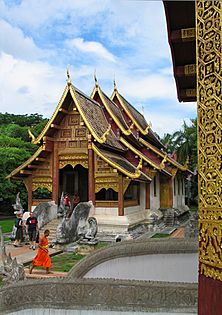
Northeastern Thailand (Isan) Provinces
- Amnat Charoen
- Bueng Kan
- Buri Ram
- Chaiyaphum
- Kalasin
- Khon Kaen
- Loei
- Maha Sarakham
- Mukdahan
- Nakhon Phanom
- Nakhon Ratchasima
- Nong Bua Lamphu
- Nong Khai
- Roi Et
- Sakon Nakhon
- Si Sa Ket
- Surin
- Ubon Ratchathani
- Udon Thani
- Yasothon
Southern Thailand Provinces
- Chumphon
- Krabi
- Nakhon Si Thammarat
- Narathiwat
- Pattani
- Phang Nga
- Phatthalung
- Phuket
- Ranong
- Satun
- Songkhla
- Surat Thani
- Trang
- Yala
How Thailand is Governed
Before 1932, Thai kings were absolute monarchs. This meant they had all the power. In the Sukhothai Kingdom, the king was seen as a Dharmaraja. This means a king who rules fairly. Modern absolute monarchy began when King Chulalongkorn made Thailand a single, unified state. On June 24, 1932, a group called Khana Ratsadon (People's Party) led a peaceful change. This started Thailand's constitutional monarchy.
Thailand has had 20 constitutions since 1932. The current one is from 2017. All constitutions say Thailand is a constitutional monarchy. However, the government has sometimes been a military dictatorship and sometimes a democracy. Thailand has had many changes in government by the military. "Military leaders have governed Thailand for 55 out of 83 years" between 1932 and 2009. Most recently, the military ruled from 2014 to 2019.
Thailand's government has three main parts:
- Legislative branch: This is the National Assembly. It makes laws. It has two parts: the Senate (200 members) and the House of Representatives (500 members). The House members are elected by the people.
- Executive branch: This includes the Prime Minister of Thailand and other cabinet members. The Prime Minister leads the government. The National Assembly chooses the Prime Minister.
- Judiciary: This is the court system. It is supposed to be separate from the other two branches. However, some people believe court decisions are sometimes influenced by politics.
Thailand's Economy: How the Country Makes Money
| Economic indicators | ||
|---|---|---|
| Nominal GDP | ฿14.53 trillion (2016) | |
| GDP growth | 3.9% (2017) | |
| Inflation • Headline • Core |
0.7% (2017) 0.6% (2017) |
|
| Employment-to-population ratio | 68.0% (2017) | |
| Unemployment | 1.2% (2017) | |
| Total public debt | ฿6.37 trillion (Dec. 2017) | |
| Poverty | 8.61% (2016) | |
| Net household worth | ฿20.34 trillion (2010) | |
Thailand's economy relies heavily on exports. Exports make up more than two-thirds of its total economic output. Thailand sells over US$105 billion worth of goods and services each year. Key exports include cars, computers, and electrical appliances. They also export rice, textiles, footwear, and rubber.
Thailand is an emerging economy. It is considered a newly industrialized country. In 2017, Thailand's economy was worth US$1.236 trillion. It is the second-largest economy in Southeast Asia, after Indonesia. Thailand is the fourth richest nation in Southeast Asia based on income per person.
Thailand helps the economies of its neighbors like Laos, Myanmar, and Cambodia. In late 2014, Thailand's unemployment rate was very low, at 0.84%. In 2017, the Thai economy grew by 3.9%. This was its fastest growth since 2012.
Exports and Manufacturing
Thailand's economy depends a lot on selling goods to other countries. Exports make up over two-thirds of its economy. Major exports include cars, computers, and electrical appliances. They also export rice, textiles, footwear, and rubber.
Important industries include electric appliances and vehicle parts. Thailand's economy recovered from the 1997–1998 Asian financial crisis mainly because of exports. As of 2012, the Thai car industry was the largest in Southeast Asia. It was the 9th largest in the world. Thailand produces about 1.5 million vehicles each year, mostly commercial vehicles.
Most vehicles made in Thailand are designed by foreign companies. These are mainly Japanese and American. The Thai car industry uses the ASEAN Free Trade Area to sell its products. Thailand was the second-largest buyer of pick-up trucks in the world in 2012, after the US. This is because of lower taxes on 2-door pick-ups.
Tourism: A Big Part of the Economy
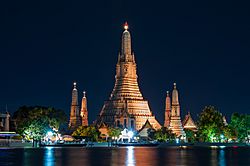
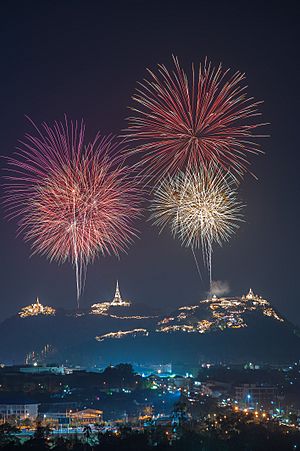
Tourism makes up about 6% of Thailand's economy. Before the pandemic, Thailand was the world's eighth most visited country. In 2019, Thailand welcomed 39.8 million international tourists. It earned the fourth-highest amount from tourism, at 60.5 billion US dollars.
Thailand was the most visited country in Southeast Asia in 2013. Tourism directly adds about 9% to 16% to Thailand's economy. When you include indirect effects, it accounts for over 20% of Thailand's economy.
Asian tourists often visit Bangkok and its historical sites. Western tourists also visit Bangkok, but many travel to the southern beaches and islands. The north is popular for trekking and adventure. It has diverse ethnic groups and forested mountains. The Isan region gets the fewest tourists. To help foreign visitors, a special tourism police force was created.
Thailand is a top destination for medical tourism. It ranks fifth globally for medical tourism spending. In 2018, it attracted over 2.5 million medical visitors. It is also Asia's number one medical tourism destination.
Agriculture and Natural Resources
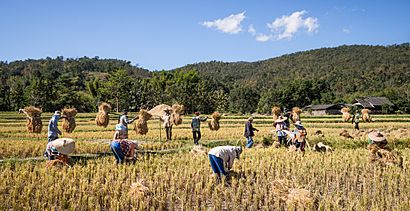
Almost half of Thailand's workers (49%) are in agriculture. This is down from 70% in 1980. Rice is the most important crop. Thailand used to be the world's top rice exporter. Now, India and Vietnam export more. Thailand has a high percentage of farmable land, 27.25%. About 55% of this land is used to grow rice.
Farming in Thailand is changing. It's moving from traditional methods to more industrial ones. Between 1962 and 1983, farming grew by 4.1% each year. It continued to grow by 2.2% until 2007. Agriculture's share of the economy has decreased as exports of goods and services have grown.
Thailand uses more natural resources than it has. In 2016, Thailand had 1.2 global hectares of resources per person. The world average was 1.6. But Thailand used 2.5 global hectares per person. This means they use about twice what their land can provide.
Science and Technology
Thailand ranked 43rd in the Global Innovation Index in 2021. The Ministry of Higher Education, Science, Research and Innovation guides science and technology development. In 2019, Thailand spent 1.1% of its GDP on science research. Over 166,788 people worked in research and development that year.
Getting Around: Transportation in Thailand
The State Railway of Thailand (SRT) runs all national train lines. Krung Thep Aphiwat Central Terminal and Bangkok (Hua Lamphong) are the main stations for long-distance trains. As of 2017, SRT had 4,507 km (2,801 mi) of track. Most of it is single-track. There are plans to add more double or triple tracks. Rail transport in Bangkok includes long-distance and commuter trains. Bangkok also has four rapid transit systems: the BTS Skytrain, MRT, SRT Red Lines and the Airport Rail Link.
Thailand has 390,000 kilometres (240,000 miles) of highways. As of 2017, there were over 462,133 roads. There were also 37 million registered vehicles, with 20 million being motorbikes. Many two-lane highways have been made into four-lane divided highways. Bangkok has several controlled-access highways. Other ways to travel by road include tuk-tuks, taxis, minibuses, motorbike taxis, and songthaews.
As of 2012, Thailand had 103 airports. 63 of these had paved runways. The busiest airport is Bangkok's Suvarnabhumi Airport.
Energy: Powering the Nation
In 2014, 75% of Thailand's electricity came from natural gas. Coal-fired power plants produced another 20%. The rest came from biomass, hydro, and biogas.
Thailand produces about one-third of the oil it uses. It is the second-largest oil importer in Southeast Asia. Thailand is a big producer of natural gas. It has at least 10 trillion cubic feet of reserves. It is also the largest coal producer in Southeast Asia after Indonesia. However, it still needs to import more coal.
Language: How People Communicate
The official language of Thailand is Thai. It is a Kra–Dai language. It is similar to Lao and Shan. Thai is used in schools and government. It is spoken across the country. Standard Thai is based on the dialect of central Thai people. It is written using the Thai alphabet. The Royal Thai Government recognizes 62 languages.
The largest minority language is the Lao dialect of Isan. This is spoken in the northeastern provinces. In the far south, Kelantan-Pattani Malay is the main language for Malay Muslims. Many Thai Chinese people also speak different types of Chinese. The Teochew dialect is the most common. Many tribal languages are also spoken. These include Mon, Khmer, Karen, and Hmong.
Thai Culture: Traditions and Arts
Thai culture mixes influences from India, China, and other Southeast Asian countries. Theravada Buddhism, Thailand's main religion, is very important to Thai identity. Thai Buddhism has also taken in local beliefs. These include parts of Hinduism, animism, and ancestor worship. The official calendar in Thailand is based on the Eastern Buddhist Era.
Many different ethnic groups have shaped Thai culture. Overseas Chinese people are a big part of Thai society, especially in Bangkok. They have become successful in business and politics.
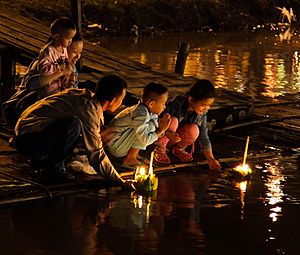
Respect for elders and those in higher positions is a key Thai value. Respect for ancestors is also important. Thai people have a strong sense of social order. This is shown in their use of honorifics. Elders traditionally make family decisions. The Wai is a traditional Thai greeting. It is usually offered first by a younger person. Thais are known for being very welcoming and generous.
Some things are considered rude in Thai culture. For example, touching someone's head or pointing with your feet. The head is seen as the most sacred part of the body. The feet are considered the lowest.
Art: Expressing Thai Identity
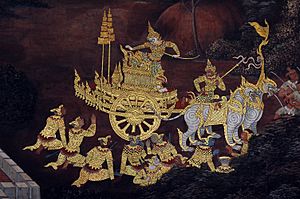
Thai art was greatly influenced by Buddhist art and Indian stories. Traditional Thai sculpture mostly shows images of the Buddha. These are similar to other styles in Southeast Asia. Traditional Thai paintings often illustrate books. They also decorate buildings like palaces and temples. Thai art was influenced by earlier civilizations. By the Sukhothai and Ayutthaya periods, Thai art developed its own unique style. It was later influenced by Sri Lankan and Chinese art. Kings and royal courts supported art. They built temples and religious shrines.
Early Thai paintings showed subjects in two dimensions. They did not use perspective. The size of an object showed its importance. Main elements were separated by space. This avoided showing depth. Perspective was only added after Western influence in the mid-19th century. Monk artist Khrua In Khong was the first to use linear perspective in Thai art.
Common painting subjects included Jataka stories. These are tales from the life of the Buddha. They also showed Buddhist heavens and hells. Themes from Thai versions of the Ramayana and Mahabharata were also popular. Scenes of daily life and Thai folklore were also painted.
Architecture: Buildings with Meaning
Architecture is a very important part of Thailand's culture. It shows how people lived in Thailand's climate. It also shows the importance of community and religion. Thai architecture has been influenced by its neighbors. It also has different styles in different regions.
The Ayutthaya Kingdom was a very creative time for Thai architecture. Buildings from this period were designed to show power and wealth. They were large and grand. Temples in Ayutthaya often had open designs. This allowed sunlight to shine inside. Ayutthaya architecture is seen as a peak achievement. It met people's needs and showed Thai gracefulness.
Buddhist temples in Thailand are called "wats." This word means an enclosure. A temple has a wall that separates it from the outside world. Wat architecture has many different layouts and styles. But they all follow the same basic ideas.
Literature: Stories and Poems
Thai literature has a long history. Even before the Sukhothai Kingdom, there were oral and written stories.
During the Sukhothai Kingdom, most writings were simple prose. They often used alliteration. Important works include the King Ram Khamhaeng Inscription. This describes life at that time. It is considered the first Thai literary work in Thai script. Trai Phum Phra Ruang, written in 1345, explains Buddhist philosophy. It is seen as the nation's first research paper.
During the Ayutthaya Kingdom, new poetic forms were created. These had different rhymes and rhythms. Often, different poetic forms were combined in one work. Lilit Yuan Phai is a poem about a war. One beautiful work is Kap He Ruea. This poem is traditionally sung during royal boat processions.
The Thon Buri Period produced Ramakian. This was a verse drama by King Taksin. This time marked a rebirth of literature after Ayutthaya fell.
During the 18th century Rattanakosin period, many works were about war. Examples include Nirat Rop Phama Thi Tha Din Daeng. King Rama I completed the important work of Ramakian. Other performances included musical recitals like Mahori. The most important Thai poet of this time was Sunthorn Phu. He is known for his epic poem Phra Aphai Mani.
Some famous modern Thai writers include Kukrit Pramoj and Chart Korbjitti.
Music and Dance: Rhythms and Movements
Besides folk dances, Thailand has two main classical dance forms: Khon and Lakhon nai. At first, these were only for royal courts. Later, a popular dance theater style called likay developed for common people.
Folk dances include dance theater like likay. There are also regional dances (ram). The ritual dance ram muay and homage to the teacher, wai khru, are also folk forms. Both ram muay and wai khru happen before all traditional muay Thai matches. The wai is also an annual ceremony for Thai classical dance groups. They do it to honor their artistic ancestors.
Thai classical music refers to court music. It developed in central Thailand about 800 years ago. These musical groups are now uniquely Thai. The three main classical groups are the Piphat, Khrueang sai, and Mahori. They share basic instruments and musical ideas. They all use small ching hand cymbals and krap wooden sticks to mark the beat. Thai classical music has influenced music in nearby countries.
Cuisine: A Taste of Thailand
Thai food is very popular worldwide. Thai food mixes five main tastes: sweet, spicy, sour, bitter, and salty. Common ingredients include garlic, lemongrass, kaffir lime, and coconut milk. Each region has its own special dishes. For example, kaeng khiao wan (green curry) is from central Thailand. Som tam (green papaya salad) is from the northeast.
In 2017, seven Thai dishes were on a list of the "World's 50 Best Foods" by CNN Travel. Thailand had more dishes on the list than any other country. These included tom yam goong (4th) and pad Thai (5th). Two desserts were also listed: mango sticky rice and tub tim krob.
Rice, especially jasmine rice, is the main food in Thailand. It is part of almost every meal. Thailand is a top exporter of rice. Thais eat over 100 kg of rice per person each year. Thailand is also a leader in the edible insect industry. Bangkok is famous for its street food.
Images for kids
-
Siamese envoys presenting letter to Pope Innocent XI, 1688
-
Parliament House, the meeting place of the two chambers of the National Assembly of Thailand
-
People's Alliance for Democracy, yellow shirts, rally on Sukhumvit Road in 2008
-
The HTMS Chakri Naruebet, an aircraft carrier of the Royal Thai Navy
-
The population of Asian elephants in Thailand's wild has dropped to an estimated 2,000–3,000.
-
Chulalongkorn University, established in 1917, is the oldest university in Thailand.
-
The BTS Skytrain passes through Sathon, the business district of Bangkok, the capital of Thailand and the country's largest commercial and financial centre.
-
Statue of a mythical Kinnon, Wat Phra Kaew, Bangkok
-
An Airbus A380 of the national carrier Thai Airways
-
Theravada Buddhism, highly practised in Thailand
-
Muay Thai, Thailand's signature sport
-
Pottery discovered near Ban Chiang in Udon Thani Province, the earliest dating to 2100 BCE
-
Phimai, Prasat Phimai is the largest temple in the country from the Khmer Empire.
-
Painting of Ayutthaya C 1665, by Johannes Vingboons, ordered by the Dutch East India Company
See also
 In Spanish: Tailandia para niños
In Spanish: Tailandia para niños





